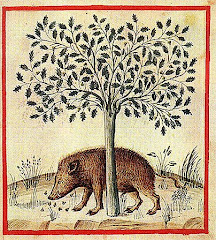
Click Here for more about the Royal Pharmaceutical Society at
Apotheca
(http://apotheca.myspecies.info)
Apotheca
(http://apotheca.myspecies.info)
A trip to London not so long ago included a visit to theMuseum of the Royal Pharmaceutical Society. Finding so few mentions of this museum on the net, I thought I'd share my experiences for those that are interested.
Certainly, it cannot be denied that the museum is small. I walked into the RPS reception and announced my desire to visit the museum. "You're in it" I was cheerfully told and, sure enough, when I looked around the foyer I spotted maybe 5 glass cases (some of which I won't cover because they weren't herbal enough) of artefacts with a series of laminated pamphlets to accompany them.
So I thanked the receptionist and set to work at the first case, determined to absorb as much as I possibly could from the displays.
Now, small though the physical 'volume' of the museum is, it makes up for it with the sheer number of interesting artefacts crammed into each case. Every item was numbered and the pamphlets I held described each one clearly. The opportunity to acquire information in this museum is immense. Far greater, I would say, than in your average "family-fun" museum which will so frequently reduce interpretation down to idiot-proof levels.
The cases were all themed. Beginning with the history of pharmacy, and doing justice to the herbs upon which all modern medicine is based, I was confronted which 3 or 4 shelves displaying a few small samples of dried herb material, images of medieval apothecaries, mortars & pestles - all the usual (but utterly fascinating) things. To be honest, this is the case that would have interested me the most, but since the display consisted of so many artefacts with which I regularly work anyway, I felt I had less to learn here and so I turned to the next case as soon as I felt I had browsed all items and everything on the pamphlet at least once.
The second case also had a theme, but a far less obvious choice than the first. The 3 shelves in this case were devoted, one each, to Female, Male, and Child health. In spite of having a far less 'herbal' theme than the last case, this one fascinated me immensely. Several conditions were covered within each theme and artefacts were displayed in their dozens. The remedies on offer ranged from smelling salts for "ladies with a weak constitution" and powerful tonic pills for men (presumably also with a weak constitution, but unwilling to admit so) to interesting herbal concoctions labelled simply 'ladies pills' with only the vaguest explanations about what they were intended to do (one can only guess) and modern Viagra. The children's shelf seemed largely to be about teeth and I confess I didn't really bother with that one, the other two absorbed me so completely. If only I could remember a few specifics about the things I saw, but my useless memory lets me down as always.
Anyway, as I was busily cross referencing artefact with description as systematically as only I would bother to know how, the curator of the museum (who I believe is called Bryony?) came out to measure the cabinet I was looking at. She told me all about their huge collection of artefacts, their efforts to find a balance between interesting levels of interpretation and cramming the cases full to bursting. She openly admitted that even though they had displayed less this year than ever before, the case was still too full. I openly disputed that in return! And she told me they were just in the planning stage for their new display, with new themes, that would open for science week and continue throughout next year.
All this sounded so proactive and positive to me. I was really impressed with what she told me about how they plan themes for these small cases each year and then add the interpretation they've produced from it to an online directory when they've finished with it. Inevitably the conversation came around to the pharmacy at the National Botanic Garden of Wales which I always hoped we could develop and improve. I was surprised to find she had actually visited us at NBGW, but no surprise since it turns out she's good friends with Professor Terry Turnerwho is central to all things pharmaceutical at the gardens.
So a thoroughly enjoyable visit which certainly took some time in spite of its small size. It left me wondering how much time is actually spent on it by them. If a museum of that size can have a curator, even a part-time one, it begs the question why the NBGW pharmacy doesn't. Oh how easy things must be for a London institution with stacks of dosh! But well done to them anyway.
~~~*~~*~~*~~~
[At the time of writing] The Royal Pharmaceutical Society Museum is open from 9am until 5pm, Mon-Fri. Entrance is free and pre-arranged tours are available which include a wider range of exhibits.
The Museum can be found on the ground floor of the Royal Pharmaceutical Society headquarters on Lambeth Road about halfway between the Lambeth North and Vauxhall Cross stations.
For those who are interested, the Museum of Garden History is directly across the road, but charges a £6 admission fee so I didn't bother.




















No comments:
Post a Comment